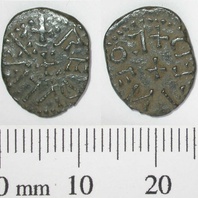
Viking Objects
Northumbrian Styca (DENO-60AFD2)
This copper-alloy styca was probably minted by the moneyer Coenred in the name of King Redwulf of Northumbria. While Wessex and Mercia were using silver coinage as part of their monetary economy, Northumbria was using copper coins known as stycas, which may have contained trace amounts of silver. The concentration of these coins at sites such as Torksey and ARSNY suggests that they could have remained in circulation after the fall of Northumbria in 866 but were taken to the sites by the Vikings during their campaigning. They were not much use to the Vikings within their silver-based bullion economy but it is suggested that they were treated as raw material and were used as commodity money instead. The evidence for the production of copper alloy strap-ends at Torksey and ARSNY supports this idea that the stycas were used for production.
Read More
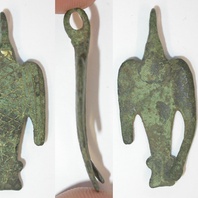
Viking Objects
Bird Pendant (DENO-55AE35)
A pendant of similar shape although with different decoration is dated to the second half of the ninth century from Yaroslavl, Russia. The bird symbol, very similar to the one depicted on this pendant, was used by the Rurik dynasty which had started the conquest of Slavic lands in the mid-ninth century and later formed the polity of Rus’. With some exceptions, pendants were generally worn by women as an accessory to Scandinavian dress.
Read More
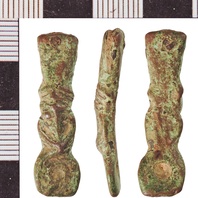
Viking Objects
Zoomorphic Strap-End (NLM-09BBD5)
This cast zoomorphic strap-end has been classified as Thomas Class G and contains decoration consisting of a heart-shaped muzzle, small pellet eyes, and angular grooves which may represent brows. Strap-ends came in various styles and were fairly common throughout the Viking world. They were used to decorate the ends of belts and to stop them getting damaged.
Read More
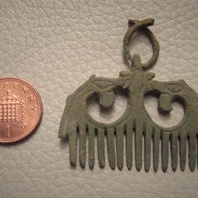
Viking Objects
Comb Pendant (NARC-B3E1B5)
This pendant is unusual for the British isles and has Eastern Scandinavian or Baltic origin. The pendant is decorated with Ringerike-style zoomorphic openwork ornament with a pair of inturning zoomorphic heads. Pendants were a popular dress accessory in Norway and Sweden and sometimes were worn with beads between a pair of oval brooches. In England, pendants did not have the same popularity and there do not seem to be any contemporary Anglo-Saxon pendants.
Read More
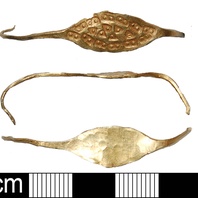
Viking Objects
Gold Finger-Ring (BH-59ECD3)
An Anglo-Scandinavian gold finger-ring decorated with a punched a lozenge-shaped pattern of six triangles with central dots, surrounded by a circumferential band of punched rectangles with two dots. The ends of the wires are hooked, showing that they would originally have been twisted together. Rings like this with knotted ends are typically Scandinavian.
Read More
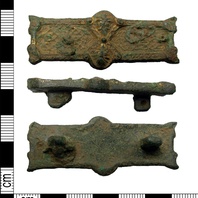
Viking Objects
Gilded Mount (LEIC-127138)
This mount is decorated with rope-like raised decoration, flanked by a plain raised edge. The centre of the mount is decorated with a raised ‘saltaire’ cross. Above and below this cross are semi-circular projections which form the upper part of human face masks which face each other. The remainder of the upper surface is filled with loose ‘chip carved’ interlace. The whole upper surface has patches of gilding, suggesting it originally covered the whole surface. It is possible that it made its way to England prior to Viking incursions but it is equally likely that the Vikings brought this brooch with them as plunder after raiding various areas in Ireland.
Read More
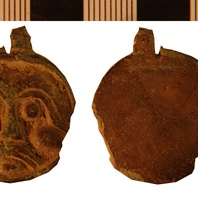
Viking Objects
Copper-Alloy Disc Pendant (NLM-0CA344)
This cast copper-alloy disc pendant has an anthropomorphic design which portrays a facing moustachioed mask. A dark grey coating on front and back may be the degraded remains of a silvered surface. Pendants were a popular dress accessory in Norway and Sweden and sometimes were worn with beads between a pair of oval brooches. For more information on Scandinavian jewellery in England check out our blog: Brooches, Pendants and Pins: Scandinavian Dress Accessories in England.
Read More
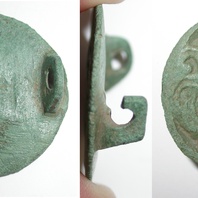
Viking Objects
Borre Style Brooch (DENO-805B20)
This copper-alloy brooch is an example of Kershaw’s East Anglian series and is decorated with interlaced Borre-style designs. For more information on Scandinavian jewellery in England check out our blog: Brooches, Pendants and Pins: Scandinavian Dress Accessories in England.
Read More
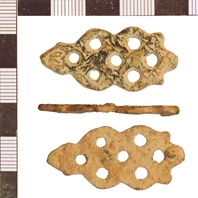
Viking Objects
Anglo-Scandinavian Mount (NLM-491EBD)
This copper-alloy mount is decorated with an openwork plate interlace ornamentation in possible Borre style.
Read More
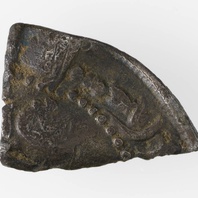
Viking Objects
Abbasid Silver Dirham Fragment (CM_1775_2008)
A silver dirham fragment possibly minted at al-`Abbasiyya. The dirham was a unit of weight used across North Africa, the Middle East, and Persia, with varying values which also referred to the type of coins used in the Middle East during the Viking Age. These coins were extremely prized possessions not only for their silver value but as a way of displaying one’s wealth and vast trade connections. Millions of Arabic dirhams would have been imported throughout the Viking world and are mostly found in hoards.
Read More
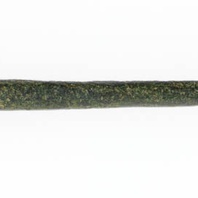
Viking Objects
Needle (CM. 1844-2008)
A cylindrical copper-alloy needle with a circular eye punched into a flattened section. Needles were a common textile tool and could be made from bone, metal or wood. They are generally considered to indicate the presence of female craftspeople, reinforcing the view that the Viking camp at Torksey was inhabited by women and children as well as the warriors of the Great Heathen Army.
